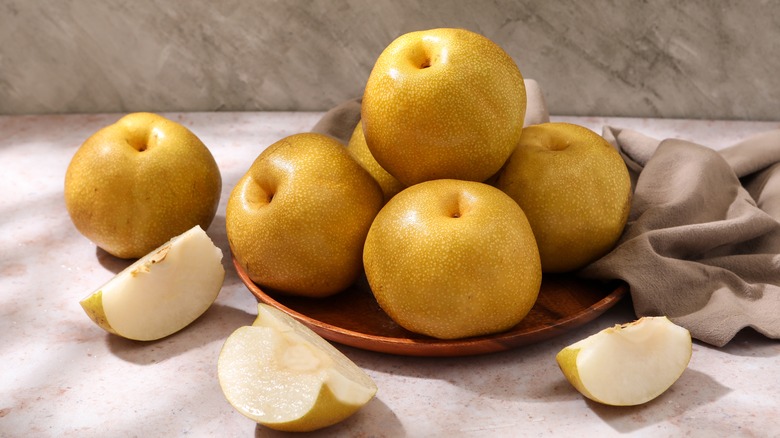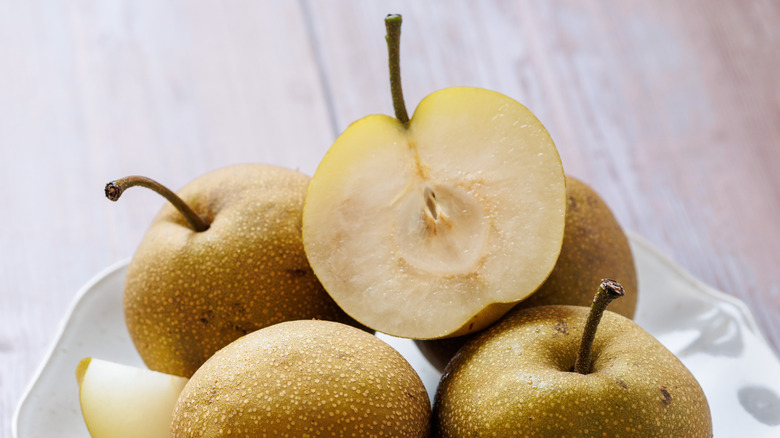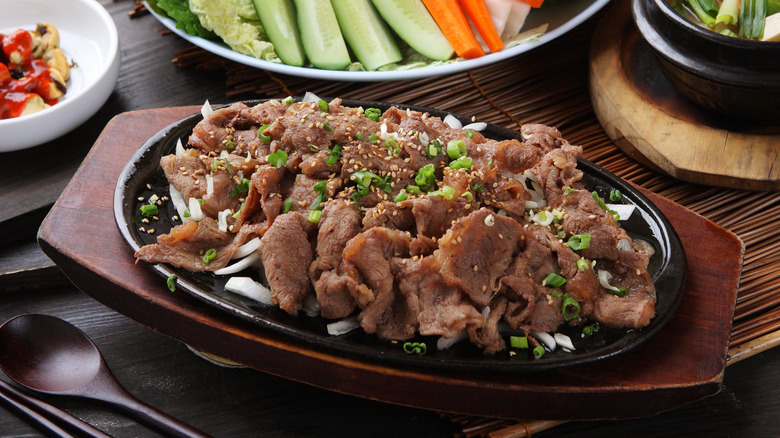The Reason Asian Pears Are Best Enjoyed Raw
The Asian pear, also known as the Japanese pear, the apple pear, or the Chinese pear (among other names), encompasses thousands of varieties of pear native to Eastern Asia. Asian pears, which are an entirely different species than European pears, originated in China and can be traced back 3,000 years. Some say they were first introduced to the U.S. in the 1800s, in California, by Chinese laborers. Unlike European pears, which can be delicious in a variety of preparations — from getting poached in red wine and served as a dessert, to being the unlikely ingredient to add to a hearty lentil soup – Asian pears are best left away from the stove.
An Asian pear typically holds an oval shape, almost akin to an apple, and a lightly dotted pattern so uniform it looks like a decoration. The dark yellow skin has a slightly coarse texture, and once cut, it gives way to beautifully clean ivory flesh. Eaten with the skin or peeled, the Asian pear is notably crunchy and juicy, imbued with floral characteristics and a sweet-tart flavor. In Asia, this variety of pear is cherished in its raw, crisp form. It needs no accompaniment as its delicate, fresh flavor is believed to be enough to satisfy.
However, this is not to say there aren't ways it can't be incorporated raw in other dishes. Let's dive into these and more of the contrasts.
A brief comparison of pear species
To best understand why Asian pears are so prized in their raw forms, it's best to illustrate some differences from European pears. Bosc, Andjou, and Concorde are crispy European pear varieties that retain their shape once heated, such as when grilled or poached. Asian pears are relatively high in water, so they are unlikely to keep their round shape once heated.
Regarding baking, Anjou, Bartlett, and Bosc pears are considered sublime options. A slightly firm variety can withstand high heats, which make them excellent options for tarts or pies. This is where the high water characteristic of an Asian pear is also undesirable, as the pear is likely to add additional moisture to any dessert, and, face it, no one wants a soggy bottom.
With that in mind, it is not unheard of to use Asian pears in baked, grilled, or poached recipes. The mild flavor of the Asian pear beautifully complements warm spices such as sweet cinnamon, earthy nutmeg, and the licorice tint of fennel. If you choose Asian pears for cooking, ensure they are firm, free from bruises, and contain no soft spots. Asian pears have exceptionally delicate skin, so you will probably recognize them at the market as they'll be wrapped in foam netting to prevent bruising.
Raw applications
Eating an Asian pear raw does not have to mean it's simply eaten out of hand, as this pear can also work wonderfully in a salad. The sweetness of the Asian pear balances bitter leaves like arugula or the earthiness of a spinach salad. Its juicy texture is wonderfully complemented by crunchy pumpkin seeds or toasted walnuts, and the salty, pungent disposition of a cheese like goat or blue will accentuate the savoriness.
Another salad-type dish this raw pear would gloriously shine in is a slaw. Mixed with cabbage, red onion, and a creamy yet tangy dressing of sour cream, mayonnaise, and apple cider vinegar, this slaw combination would be vibrantly fresh and crunchy, with pleasant acidity. The succulent Asian pear adds a mild, floral sweetness that's succulent and moreish. Lastly, a widespread use for Asian pears in Korean cuisine is in a marinade. The pear contains an enzyme called calpain, which tenderizes the meat. It would work extremely well in a beef bulgogi recipe, where the pear is blended into a paste with ginger, onion, and garlic to add a gloriously subtle sweetness to the dish.
Asian pears can be enjoyed in a variety of ways. However, for a first taste, savor it fresh; its juicy but crisp body is sure to bring a delightful experience you won't regret.


